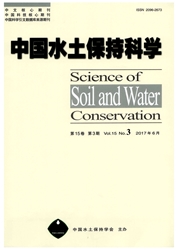

 中文摘要:
中文摘要:
在GIS技术支持下,分析陕北水蚀风蚀交错带1986—1997年土地利用时空变化,并运用马尔可夫模型对未来土地利用进行预测。采用生态弹性度,进行土地利用变化与生态效应研究。结果表明:区域1986-1997年土地利用类型变化主要是水田、旱地、其他林地、高覆盖草地、水体和建设用地增加,其他呈现减少趋势。土地利用的年均动态变化指数为2.4%,土地利用动态变化幅度远远高于绝对值变化量,土地利用类型内部转换非常剧烈。除水田、高覆盖草地和其他草地外的土地利用类型垂直重心下降。生态弹性度整体呈现下降趋势,但降解幅度减小。
 英文摘要:
英文摘要:
Based on GIS, temporal and spatial variation of land utilization in wind-water erosion cross region of northern Shaanxi from 1986 to 1997 was analyzed. Land utilization condition in future was forecasted by Markov Model, and variation of land utilization and its ecological effectiveness were investigated by ecological elastic limit. The results indicated that the main variation of land utilization is the increase of irrigated fields, dry farming field, other forest land, grassland with high coverage, water body and constructive land, and other area of land utilization showed a direction of reducing. Annual average dynamic variation index of land utilization was 2.4%, and dynamic variation range of land utilization is higher sharply than that of absolute value. The conversion within land utilization type was acute strongly. The vertical centroid of land utilization type was descending, except irrigated fields, grassland with high coverage, and other grassland. The ecological elastic limit showed downtrend wholly, but whose decreasing range was lessen.
 同期刊论文项目
同期刊论文项目
 同项目期刊论文
同项目期刊论文
 Effects of long-term fertilization and mulch on soil fertility in contour hedgerow systems: A case s
Effects of long-term fertilization and mulch on soil fertility in contour hedgerow systems: A case s The effect of land cover/vegetation on soil water dynamic in the hilly area of the loess plateau, Ch
The effect of land cover/vegetation on soil water dynamic in the hilly area of the loess plateau, Ch The effect of land uses and rainfall regimes on runoff and soil erosion in the semi-arid loess hilly
The effect of land uses and rainfall regimes on runoff and soil erosion in the semi-arid loess hilly Secondary succession and its effects on soil moisture and nutrition in abandoned old-fields of hilly
Secondary succession and its effects on soil moisture and nutrition in abandoned old-fields of hilly 期刊信息
期刊信息
